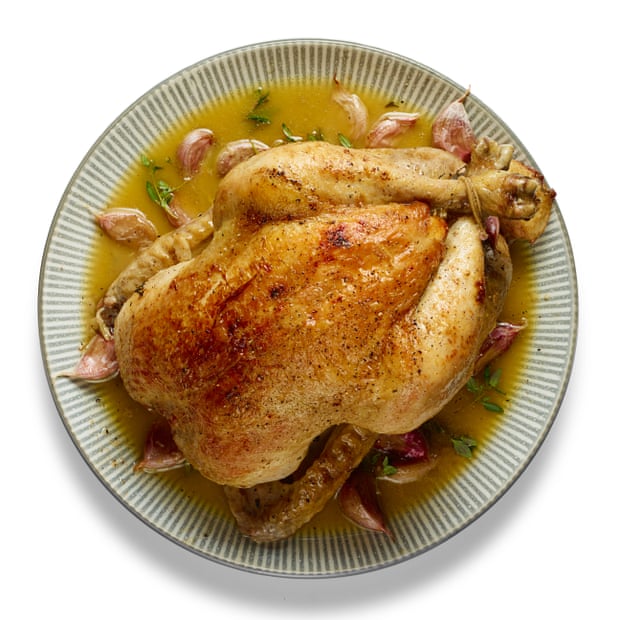A few days ago, over dinner, we were discussing food (as you do) and Noreen happened to comment that I am a good cook. The word “imaginative” was also used. Well, I’m not so sure.
I’m certainly an competent and adequate cook. I can provide a good range of simple main courses (roasts to steak to curry) without having to think about it; as witness the recipes etc. posted here over the years. Similarly I can do some basic starters (including home-made terrine), and simple tarts and pies; plus some outliers such as parmesan biscuits, cantuccini and chutney. I can do variations on all this without the need for a recipe – except for the occasional inspiration and if I (unusually) decide to do anything like cake which needs precision.
However I have no formal training; just what I’ve picked up from my mother, odd friends, Noreen and the occasional cookery book. There are many things which I’m sure I don’t do “the right way”; and there are many things I don’t/won’t do. I don’t do fancy, pretty, cake and patisserie, nor anything “tricky” like soufflé. Yes, I probably could do all these, but they’re things we’re happy to keep for eating out occasions – why go out to eat what you can do easily and as well at home? My method is basically quick, easy and wholesome; and preferably low sugar and salt. In many ways what the French would term “cuisine grand-mère”.
Even as an undergraduate I was an adequate cook. In student residences each of our kitchens had a Baby Belling, so of course I heard lots of myths about what you couldn’t do with one: you can’t do jacket potatoes, or pastry or bread in a Baby Belling. I was confident enough to disprove every one of those myths. Obviously I’ve improved over the ensuing 60-ish years.
However, I am definitely not competent to even consider going on “Masterchef” or “Bake Off”. Nor would I want to. I dislike cooking under pressure; I couldn’t turn out intricate, fancy food at the drop of a hat; I likely don’t do things the approved way; and I hate the pretentiousness of it all.
Even leaving the pressure aside, I wouldn’t want to have to cook for large numbers, nor in a restaurant. I couldn’t turn out the same dish, 27 times every evening, and ensure they’re all exactly the same. That’s not the way I work; variety is built in to my method.
I proved most of this to myself on Sunday evening when we had Salmon en Croûte with sugar-snap peas and tartare sauce; followed by Apricot Frangipane, Peach and Blackberry Tart with cream. OK, so having found a brand we like the Tartare Sauce came from a jar, the puff-pastry was (good, Jus-Rol) commercially produced, likewise the cream.
Starting a 6.30 the salmon and the tarts were in the oven before 7 and we were eating by 7.30. And that included sitting twiddling my thumbs for 15 minutes while Noreen fed the cats. This is what I did …
Salmon en Croûte
I knew we had a (500g) block of puff pastry in the fridge which needed to be used. Some weeks back the supermarket were selling packs of 2 salmon tail fillets at “3 for £10”, so we bought 6 packs, used 2 and put the other 4 in the freezer. One pack was defrosting now. I knew that wrapping the salmon would need no more than half the pastry. And so it was: half the pastry rolled out, wrapped round the two salmon fillets, which were stacked head to tail, and sealed. About 30 minutes in the oven (pre-heated to 220°C/200°C fan/gas mark 7). Sugar-snap peas take 5 minutes in the steamer. No need for potatoes as there’s plenty of carbs in the pastry. And served with a bottle of Crémant de Bourgogne.
Tarts
So how to use the other half of the pastry? I knew we had about ¼ jar of (commercial) apricot compote in the fridge. Thinking this would be too runny just to make “jam tarts” I figured that I could mix it with a roughly equal amount of ground almonds to make a frangipane-like paste. The pastry made 3 (9-10cm) tart cases in a Yorkshire pudding tin. Two of these were filled with the apricot mix. I added half a peach, some freshly-picked blackberries, a sprinkle of flaked almonds, and a tiny sprinkle of sugar to each. (The third tart case was filled with plain blackberries.) Again 20-30 minutes in the oven – in fact they came out at the same time as the salmon, so were still nicely warm when eaten. Served with double cream and a tot of Amaretto. Here’s one, literally just out of the oven …

Noreen’s comment was “I’ve eaten much, much worse in good restaurants”. And for once I was forced to agree: it was simple, quick, and used what was available; and it worked magnificently well. It wasn’t prettily presented, but it was good.
Yes, it could have been improved. I used too much pastry on the salmon. The salmon would have benefited from another veg or two to add some variety. The “frangipane” could have done with a little lift: Noreen suggested a shot of apricot or cherry brandy, I was thinking maybe some almond essence. I shall undoubtedly do both again.
So OK, I concede: maybe I am a good, everyday, cook; with the imagination to do variations. As Noreen often comments: compared with my mariner great-great-grandfather (c.1820-1905) we are living like the gentry. It’s one good thing lockdown has done: we’re actually eating better than we were before (and not putting on weight!). It’s something we can take pleasure in to get us through all the current mess.


 Anyway I chanced to look at Armagnac, and came across
Anyway I chanced to look at Armagnac, and came across 


 A baking sheet – I used one about 30cm square with a small lip.
A baking sheet – I used one about 30cm square with a small lip. Ingredients
Ingredients Ingredients
Ingredients

